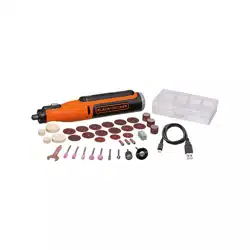Loading ...
Loading ...
Loading ...

7
ENGLISH
Charging Procedure (Fig. A, B)
WARNING: Do not use tool while it is connected to the
USB cable.
BATTERY AND CHARGER
The battery is not fully charged out of the carton. Before using
the charger to charge the battery, read the safety instructions
below and then follow charging proceduresoutlined.
The label on your tool may include the following symbols. The
symbols and their definitions are asfollows:
BPM .................... beats per minute
V ......................... volts
min ..................... minutes
j
or DC ............direct current
…/min ..............per minute
RPM .................... revolutions per
minute
A ......................... amperes
Hz .......................hertz
W ........................watts
Wh ......................watt hours
n
o
.......................no load speed
n .........................rated speed
c
.....................safety alert symbol
h
..................... wear respiratory
protection
f
..................... wear eye protection
i
..................... Class II Construction
(double insulated)
g
..................... wear hearing
protection
a
..................... read all
documentation
n
..................... avoid staring at
light
l
or AC............alternating current
Ah ....................... amp hours
• ANSI S12.6 (S3.19) hearing protection,
• NIOSH/OSHA/MSHA respiratoryprotection.
WARNING:
Some dust created by power sanding,
sawing, grinding, drilling, and other construction activities
contains chemicals known to the State of California to
cause cancer, birth defects or other reproductive harm.
Some examples of these chemicalsare:
• lead from lead‑based paints,
• crystalline silica from bricks and cement and other
masonry products, and
• arsenic and chromium from
chemically‑treatedlumber.
Your risk from these exposures varies, depending on
how often you do this type of work. To reduce your
exposure to these chemicals: work in a well ventilated
area, and work with approved safety equipment, such
as those dust masks that are specially designed to filter
out microscopicparticles.
• Wear protective clothing and wash exposed areas
with soap and water. Allowing dust to get into your
mouth, eyes, or lay on the skin may promote absorption of
harmfulchemicals. Direct particles away from face andbody.
• Use the appropriate dust extractor vacuum to remove
the vast majority of static and airborne dust. Failure
to remove static and airborne dust could contaminate the
working environment or pose an increased health risk to
the operator and those in closeproximity.
• Use clamps or other practical ways to secure and
support the workpiece to a stable platform. Holding
the work by hand or against your body is unstable and may
lead to loss ofcontrol andinjury.
• Air vents often cover moving parts and should be
avoided. Loose clothes, jewelry or long hair can be caught
in movingparts.
desire with no adverse effect on thetool.
You may charge a partially used battery whenever you
3.
charger to your local servicecenter.
If the tool does not charge properly, take the tool and
2.
a metal shed or an uninsulatedtrailer.
avoid placing the tool in a warm environment such as in
problem. To facilitate the cooling of the tool after use,
This is a normal condition, and does not indicate a
The tool may become warm to the touch while charging.
1.
Important Charging Notes
turn off and the battery will need to berecharged.
overheating or deep discharge. The tool will automatically
System that will protect the battery against overloading,
Li-Ion tools are designed with an Electronic Protection
Electronic Protection System
chargingprocedure.
illuminate, indicating that the tool has resumed the
temperature, the green charging LED
4
will continuously
Once the battery has reached an appropriate
3.
charging LED
4
remainingOFF.
The hot/cold delay will be indicated by the orange
2.
warmbattery.
A cold battery may charge at a slower rate than a1.
charging mode. This feature ensures maximum batterylife.
temperature. The tool then automatically switches to
charging until the battery has reached an appropriate
cold, it automatically starts a hot/cold delay, suspending
When the tool detects that the battery that is too hot or too
Hot/Cold Delay
batteries be recharged after eachuse.
discharge batteries fully. It is recommended that the
greatly diminished. For longest battery life, do not
batteries as soon as possible after use or battery life may
be
from a fully discharged condition. Recharge discharged
initial charge, your tool should be fully charged in 3 hour
Let the tool charge initially for at least 1 hour. After the
6.
charging or USB cable can bedisconnnected.
LEDs
4
remains continuously ON. Battery can be left
Charging is complete when the five green charging5.
to ensure charging contacts are touching.
green charging LED is not illuminated, adjust tool handle
Ensure the green charging LED
4
is illuminated. If the
4.
blink whilecharging.
computer). The green charging LED
4
will continuously
Plug the USB plug
13
into any USB port (such as on a
3.
Insert the micro USB plug
12
into the charging port
10
.
2.
thetool.
Pull the micro USB charging port cover
14
away from
1.
Loading ...
Loading ...
Loading ...
